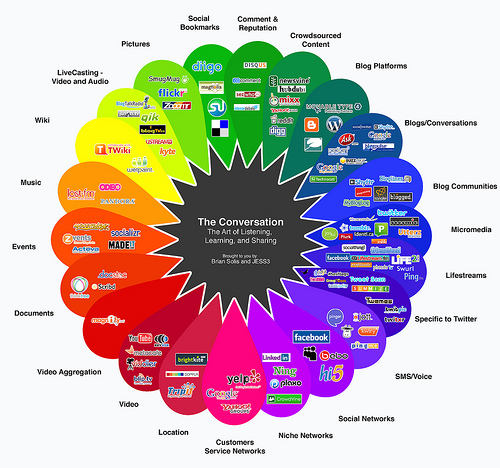By: Ken Brophy
In the age of social networking, the question is being asked more and more by both ourselves in the consulting fraternity and within our clients – what tools should we use to ensure we have a productive social presence. Is being out there (a passive presence) sufficient or should organisations be more proactive and involved in social communities? As the online dialogue gains prominence, it poses some challenging questions for organisations such as, what if people start saying things about us that we don’t like? Should we respond or not and if so, how?
Having grappled with this challenge during 2010, this article outlines some of the key learning’s from our point of view and how these can be applied in any organisation.
Learning #1 – Social Media Not Social Networking
Let’s set the stage – if you get to this point in the article and think ‘’hey, we have a Facebook page or a LinkedIn profile we are doing fine”, then please read on. Our first learning, which we believe is the first challenge is that while Facebook and LinkedIn may or may not necessarily be the answer, neither should we get hung up on the tools because there are literally hundreds of potential mechanisms you can use to drive your social presence. This is highlighted in the following diagram:

This suggests that the key issue is not social networking, but the larger issue of social media. Social Media is the key premise that all of us need to get our heads around – with the question being not “What tools do I use” but “How do I want to change the way I interact with people.” We are all social animals whether we prefer the comfort of a close friend and a bottle of wine on a Friday night or are a screaming extrovert who needs to be surrounded by hundreds of people. With that in mind, the key element we then need to focus on is the media element – how do we use social interactions to communicate information using the myriad of online tools at our disposal?
Cast your mind back to the mid 1990s when mainstream internet first reached us –
- How did you communicate and share things with your family, friends, colleagues or clients?
- What were the key mechanisms by which you were able to stay abreast of market changes or industry developments?
- How did you research, buy and then provide feedback on products and services?
Fifteen years later and our world has changed because of the impacts of social media –
- The speed at which we move
- The extent of privacy or not that we enjoy
- The relationships and purchasing habits around brands let alone the loyalty to them
- Who we deem to be experts and reliable sources of information and expertise
- Lastly and potentially the most important for us as specialists in change, the impact on ‘’corporate hierarchy.’’
Learning #2 – Social Media is Changing Organisation Interactions & Power Structures
With response times being condensed and conversations shifting, the power of the internet is allowing those within and outside an organisation to totally subvert the hierarchy that exists within it. Recent examples of the backlash against Nestle, Fonterra, BP or GAP point strongly to the fact that through effective use of social media there is a huge increase in the levels of participation surrounding a cause that people feel passionate about.
This is irrespective of whether it is negative or positive – research the levels of support for the “Smell like a man, man” campaign for Old Spice and you will find that as of early November there had been over 140 million video (official and unofficial) downloads on this topic within YouTube. Closer to home, a client that we work with found that during a recent change there was a larger Facebook presence than on their own more, admittedly, traditional channels (e.g. the internet, ask the CEO
emails, etc) discussing the issues surrounding the ongoing organisational changes. This information and dialogue on Facebook was undermining (not always factually) the efforts of the senior managers in this business.
Social media relates to how best we use media to support social interactions and make these interactions engaging and worthwhile so that people are drawn to them. Conversations among humans sound exactly that – human. Overt control (once it has gone through the multiple layers of marketing, legal, HR, regulatory, and so on) make conversations seem less human (and thus less effective). As people get more connected, they are better armed to smell the BS. Think of the last time you believed a company’s official marketing pitch on a product; rather more and more of us are using feedback on consumer forums to make our purchasing decisions. Herein lies the risk for organisations who need to think very carefully about what it is they are trying to control and how they are going about it. Given the conversations going on both within and outside of organisations – as per the examples above – we are seeing more and more the impact of social media on the command and control mentality. Our ability to link to additional information subverts and challenges this formal hierarchy.
Learning #3 – Organizations Need to Monitor and Influence their Brand Online
As such, we don’t feel it is a case of whether you should have an online presence it is more how do you monitor the social media space, building your online reputation so that you can build trust with others – whether internal or external. Where you sit then comes down to where you want to be on a continuum from simply listening to what is being said to using more formal channels to responding via actively blogging, tweeting or creating pages on the different social media sites to shape the message.
From our perspective, these issues and dynamics are forcing organisations to review the way they lead significant organisational changes – including strategy, design, culture, and leadership – through to how we package and deliver services. Key concepts that our clients and us are experimenting with include:
- Do we need to be listening to the marketplace? The answer is absolutely. As such, what is it you are trying to achieve and within what demographic? Irrespective of whether this is external or internal to your business why are you listening, who should you be listening to, what are you listening for and how will you best respond? Once you have answered some of those questions you can then contemplate the most appropriate tool – e.g. RSS feed, Google alerts, etc. – to support this listening with the next question then deciding on the most appropriate forum to respond.
- As an organisation that works with clients across industries, one of the things we have found is a lack of forums for senior members of organisations – whether that be CEOs, Heads of HR, CTOs, et al. – to get together with colleagues in similar organisations to share learning’s and solve collective challenges. In the past, we have looked to create these forums using more traditional means. Recently, we have been able to bring additional value by using social media platforms to allow the conversations started in traditional settings to continue online.
- If you are a business going through change at present, listen in on the social space, it can be a little scary. So how will you respond? The truth is there will be times when you won’t, leaving the power of the social space to ‘have your back.’ There will be other times that you will need to use the key themes from the social space to influence the traditional or non-traditional mediums used by the CEO or communications team. There will be other times when you will want to proactively respond to this feedback within the social media space (even referring people back to an alternative social space to engage with others in the debate). The key is to have thoughts about how you will manage the social media space prior to starting your change. If you do wish to respond then we advise having response guidelines including but not limited to, what are the principles that will guide the response, who will respond, how they will respond and when they will respond.
- If you are responsible for driving organisational strategy and/or design within your business there may be appropriate times to use the social media space to reinforce the work you are doing. This could range from using an appropriate mechanism to gain feedback from key stakeholders (e.g. customers or staff) prior to starting organisation strategy or design work. It could be about creating a discussion forum for preliminary outputs so as to involve more organisation members in reviewing work to date, starting people on the journey of understanding and providing insights on how the rest of the work could play out.
- In the area of leadership development, we are experimenting with using the social media space to help us to customise programme content. It can also be used to gain real-time feedback on course content while allowing facilitators to pick up on any thoughts/views throughout a programme that then need to be responded to in class. Rather than just using traditional means to evaluate the programme we are using the social media space to get thoughts and feedback from those most impacted by the leadership programme – the staff of those who attended.
- When working with those in outplacement or career transition situations, how best do you use social forums to supplement and accelerate the classwork based programmes that are facilitated on everything from CV writing, interview preparation, effective networking, financial planning or creating a support network for all those going through a similar process.
The options for leveraging social media to organisational advantage are significant as we’ve tried to highlight. In a world where the reach of your customers and/ or your staff far exceed your own control, what are you going to do to create the social setting to effectively engage these groups? Tweeting may or may not be it, but working out what you want to achieve through social media is the critical question. Whether you tweet, poke, blog, yammer or kindle is just a mechanism to effectively reach your audience of choice.
